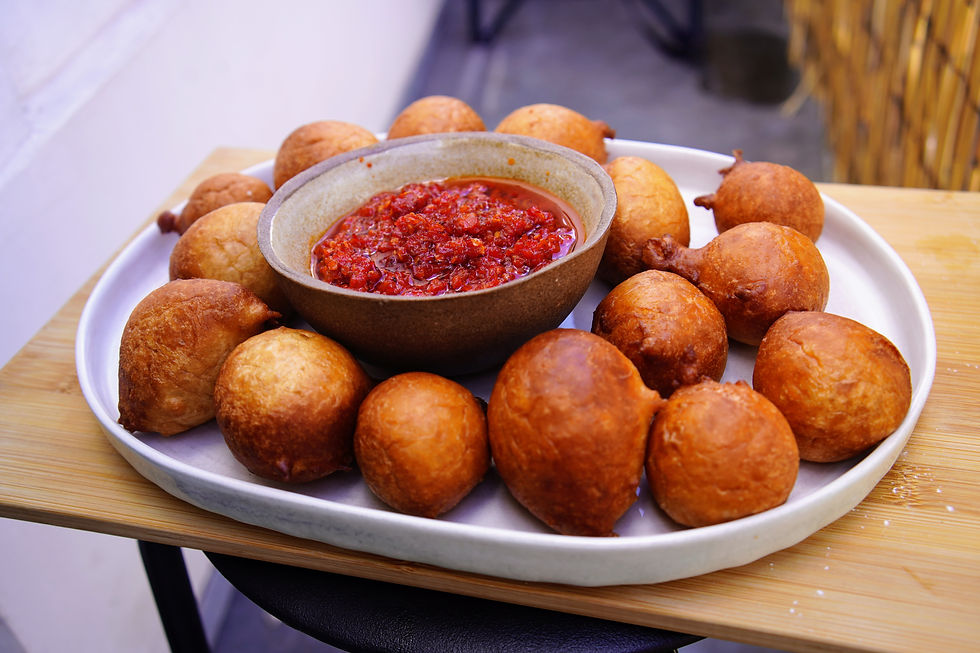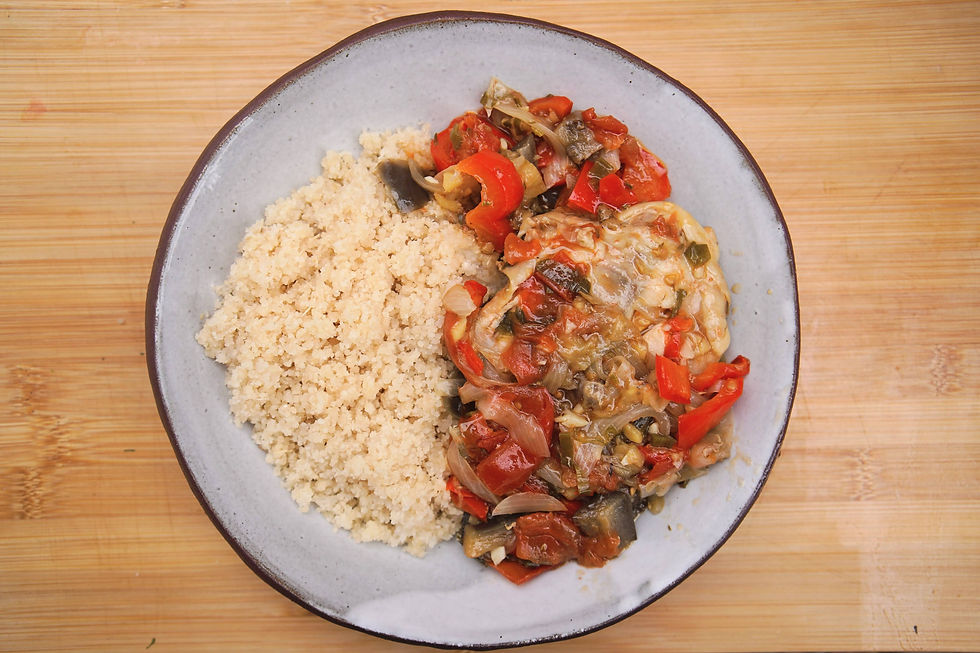Lightsoup & Fufu Recipe - A Taste of Ghana
- Pierce Jones

- Aug 6
- 4 min read
A super simple spicy tomato one pot recipe from Africa's gold coast.

Ghanaian cuisine is not just a celebration of flavor. It is a record of migration, trade, resilience, and ritual. Across the lands that stretch from the Atlantic coast to the savannahs of the north, different ethnic groups have shaped the country’s culinary identity over centuries.
Among the most influential are the Akan peoples, including the Ashanti and Fante, who dominate much of southern and central Ghana. To the east, the Ewe bring their own flavor traditions, while the Ga-Dangme of the coast and the Mole-Dagbani of the north add their distinct ingredients, techniques, and meanings to food. The dishes that have emerged from this mix are not simply meals. They are cultural touchstones passed through generations.
Among them is a dish as soothing as it is storied. Light soup is one of Ghana’s most iconic creations. Born from the kitchens of Akan households, light soup reflects the historical emphasis on fresh ingredients, medicinal cooking, and communal eating.
Unlike many other West African soups and stews that rely on rich thickeners such as groundnuts or red palm oil, light soup is brothy and elemental. Its base is a blend of tomatoes, onions, and the heat of Scotch bonnet peppers, softened by long simmering and occasionally brightened with garden eggs or okra. The broth is ladled over generous chunks of meat, often goat or chicken, though fish and game are also used, and served steaming hot.
Its popularity lies not only in its flavor but in its function. Historically, light soup has been a dish of healing and comfort. Across Akan households, it has long been the dish given to women recovering from childbirth or to elders weathering illness. The ingredients themselves reflect a philosophy of nourishment through nature. Ginger to stimulate the body, pepper to clear the sinuses, and broth to rebuild strength. It is a soup that whispers care, crafted as much for the soul as for the stomach.
The soup is rarely eaten alone. It is traditionally served with fufu, a smooth, elastic mound made by pounding boiled cassava and plantain in a heavy mortar. The act of making fufu is itself a cultural practice, often performed by two people in rhythmic coordination, one turning the dough, the other pounding.
Eating it is an equally tactile experience. A piece is pulled off with the fingers, dipped in the soup, and swallowed whole. The pairing of fufu and light soup is iconic in Ghana and deeply symbolic. Where the soup represents the vitality of the body, the fufu represents the work and unity that sustains life.
In the northern regions, light soup may be served with omotuo, or rice balls, or tuo zaafi, reflecting how regional staples adapt to the same nourishing broth. But no matter what it is served with, the heart of the dish remains unchanged. It is, for many Ghanaians, the food of memory.
The kind of meal that instantly recalls home, family, and rest after hard work.
Today, even as Ghanaian cuisine evolves and modernizes, light soup continues to hold a cherished place. It is served in small homes and major celebrations alike. It transcends tribe and region, and it remains a touchstone of Ghanaian identity.
In a world of fast food and fusion trends, light soup endures because it carries with it something far older than fashion. The comfort of heritage, the warmth of healing, and the taste of belonging.
Lightsoup & Fufu Recipe
Prep time 20 minutes | Cook time 1.5-2 hours | Serves 4
Ingredients:
For the soup:
2 pounds goat meat or chicken, cut into pieces (bone-in preferred)
1 large onion, chopped
4 medium tomatoes
2 tablespoons tomato paste
1-2 Scotch bonnet peppers (adjust to heat preference)
1 thumb-sized piece of ginger, peeled
4 cloves garlic
1 teaspoon salt, or to taste
1 bouillon cube (optional, but commonly used in Ghana)
Water (as needed, approx. 5–6 cups)
For the fufu:
2 cups cassava flour or fufu flour mix
3–4 cups water (depending on flour brand and texture)
Or use boiled cassava and green plantains if pounding the traditional way, one piece each works
Instructions
1. Season and steam the meat: Place the goat or chicken in a large pot with salt, half the chopped onion, and a little water (about 1 cup). Cover and steam on medium heat for 20 to 30 minutes to release flavor and begin tenderizing the meat. Stir occasionally.
2. Prepare the soup base: While the meat is steaming, blend the tomatoes, the remaining onion, garlic, ginger, and Scotch bonnet peppers into a smooth mixture. Add a bit of water to help the blending process.
3. Build the soup: Pour the blended mixture into the pot with the steamed meat. Add the tomato paste and additional water to reach your desired soup consistency. The soup should be brothy, not thick. Simmer gently, uncovered, for 45 minutes to an hour until the meat is tender and the flavors are well blended. Skim off any excess oil or foam from the top.
4. Adjust seasoning: Taste and adjust salt, pepper, or bouillon as needed. If using eggs or okra, add them whole during the last 15–20 minutes of cooking.
5. Prepare the fufu: If using cassava flour or fufu mix: bring water to a boil in a heavy pot. Add the flour gradually while stirring with a wooden spoon or spatula. Stir continuously over low heat until the dough pulls together into a smooth, stretchy mass. This takes about 10 minutes.
If pounding from scratch: boil peeled cassava and ripe plantains until soft. Transfer to a large mortar and pound until smooth and elastic, alternating between the cassava and plantain for even texture.
6. Serve: Scoop a portion of fufu into a bowl and ladle the hot light soup over it. Traditionally, fufu is eaten with fingers. Pinch, dip, and swallow without chewing.



Comments